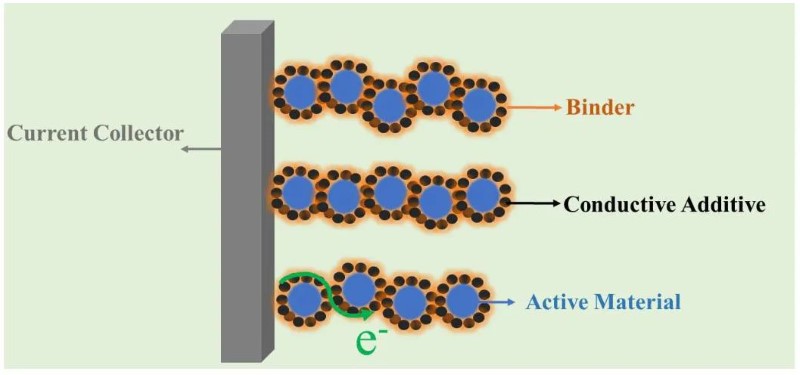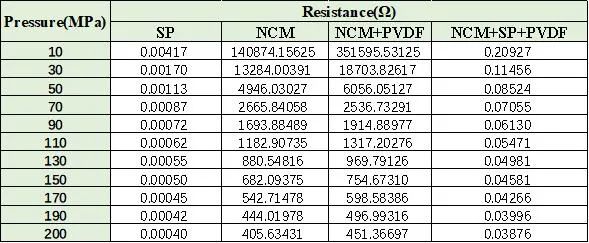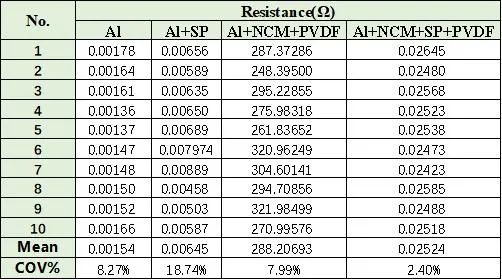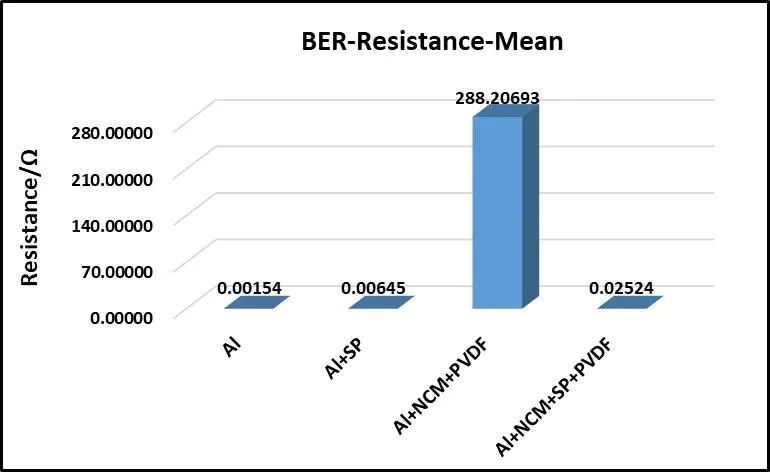How the Conductive Agent influence Electronic Conductivity of Mixed Powder & Electrode
Positive and negative electrode powder materials, separators, electrolytes, conductive agents, binders, current collectors, etc. are the main raw materials for the manufacture of lithium-ion batteries; the production of lithium-ion batteries is to process these raw materials into batteries under optimal process conditions process. Changes in the parameters of these raw materials require targeted optimization and adjustment of process conditions to obtain lithium-ion batteries with optimal electrical performance. The parameter design of positive and negative electrodes of lithium-ion batteries is the key to the development of lithium battery technology, including active material loading, porosity, thickness and the ratio between active material, conductive agent and binder. Among them, the type, content, and performance of the conductive agent are the key factors that affect the electron transport during the charging and discharging process of lithium-ion batteries, and the electronic conductivity characteristics directly determine the electrochemical performance.
In the actual electrode sheet process design, the electronic conductivity of the active material, especially the positive electrode material, is relatively poor, and the electron transport path is mainly realized by the conductive agent path. Figure 1 is a schematic diagram of the microstructure of a lithium electrode sheet in an ideal state. The electronic conductivity of the pole piece affects the basic performance of the battery, not only limited to the power performance of the battery cell, but also affects the reliability and safety performance of the battery cell. The electrode sheet resistance can better evaluate the performance of the electronically conductive network or the uniformity of the electrode microstructure during the electrode fabrication process and help to study and improve the electrode formulation and the control parameters of the mixing, coating and rolling processes. In the current research of lithium batteries, more and more researchers are paying attention to the electronic conductivity of the pole piece level, and also pay attention to the electronic conductivity of lithium battery powder materials and try to find out the correlation between the two, to directly predict the electronic conductivity of the electrode layer from the powder material level.

Figure 1. Schematic diagram of the ideal electrode microstructure
This article mainly combines NCM523 series lithium-ion battery powder materials, combined with binder PVDF and conductive agent SP to evaluate the electronic conductivity of the mixed powder after powder-level premixing, at the same time, slurry preparation and coating are carried out on powders with the same ratio, the electronic conductivity of the finished pole piece is evaluated, the influence of conductive agents on the conductivity of each layer is clarified, and its correlation is initially explored.
1. Test Method
1.1 Test Equipment: Use PRCD3100 (IEST) series powder resistance meter to measure and evaluate the electrical conductivity of powder materials; use BER2500 (IEST) series pole piece resistance meter to evaluate the conductivity of pole piece.

Figure 2. (a) Schematic diagram of PRCD series appearance & structure; (b) Schematic diagram of BER series appearance & structure.
1.2 Sample Preparation and Test
1.2.1According to: NCM: PVDF=19:1 and NCM: SP: PVDF=18:1:1 respectively, fully mix and prepare mixed powders with different NCM ratios and conduct powder resistance test within the range of 10-200MPa.
1.2.2 Prepare the slurry according to the ratio parameters in Table 1, use a 200μm scraper to manually coat, and test the resistance of the electrode.
Table 1. Slurry Ratio for Pole Electrode Preparation
Numbering | Category | Name | Mass/g | Craft |
1 | SP | Conductive agent C | 3.09 | Conductive agent C:PVDF=90:10 Stirring speed 1500, 30min; Solid Content Control 2.5%-5% |
PVDF | 0.343333333 | |||
NMP | 65.23333333 | |||
2 | NCM | NCM | 38 | NCM: PVDF=95:5 Stir speed 1500,30min; Solid content control 40% - 50% |
PVDF | 2 | |||
NMP | 40 | |||
3 | NCM+SP | NCM | 36 | NCM:conductive agent C: PVDF=90:5:5 Stir speed 1500,30min Solid content control 40% - 50% |
Conductive agent C | 2 | |||
PVDF | 2 | |||
NMP | 40 |
2.Test Results
The powder resistance test was carried out on SP, NCM and mixed powder NCM+PVDF and NCM+SP+PVDF respectively, It can be seen from the test results in Table 2 and Figure 3 that, no matter at low pressure or high pressure, after adding binder PVDF to the NCM active powder, the electronic conductivity is obviously deteriorated. However, after adding SP with better conductivity, the electronic conductivity of the mixed powder was significantly improved. In the process of evaluating the electronic conductivity of the positive active powder of lithium-ion batteries, the electronic conduction is mostly the contact conduction between particles, After adding PVDF powder with poor electronic conductivity, the PVDF powder will reduce the proportion of contact between the original active particles, resulting in a change in the overall conduction path, which in turn will lead to a decrease in the overall electronic conductivity.
The role of the conductive agent in the lithium-ion battery electrode is to provide a channel for electron transmission. An appropriate amount of the conductive agent content can obtain relatively high discharge capacity and good cycle performance, if the content of conductive agent is too high or too low, it will affect the electrical performance. If the content of conductive agent is too high, the relative content of active material will be reduced, which will reduce the specific capacity of the battery, when the content is too low, there are few electronic conduction channels, which is unfavorable for high-current charge and discharge, and the utilization rate of active materials in the electrode is relatively low. From the test results of the powder resistance, the conductive agent SP has a very superior electronic conductivity compared to the active powder NCM, after adding SP to the NCM+PVDF mixed powder, the electronic conductivity of the powder within the full pressure range has also been significantly improved, the main reason is that after the addition of SP with good conductivity, the electronic conduction path in the actual powder measurement process changes, more are transported along the SP path with better conductivity, which further clarifies the main role of the conductive agent in the lithium ion battery electrode.
Table 2.Comparison Table of Powder Resistance Test Results


Figure 3. Powder resistance test results under pressure conditions of 10MPa & 200MPa
In order to further clarify the correlation of electronic conductivity between materials, the slurry was prepared according to the ratio in Table 1 for different powders, and the scraper was used for manual coating under the same conditions. Table 3 & Figure 4 show the test results of electrode resistance. The electronic conductivity of the electrode is quite different under different ratios. Compared with Table 2 & Figure 3, the mixed powder resistance results, at the pole piece level, the conductivity is also rapidly improved after adding the conductive agent SP. It is further clarified that the addition of the conductive agent at the premixed powder level or the pole piece level can effectively enhance the electronic conduction path. The optimization of the ratio of the conductive agent is also crucial in the development stage of the actual electrode process. The amount of the conductive agent is closely related to the particle size of the conductive agent material and the ratio of the active material. The larger the specific surface area of the active material is, the larger the particle size of the conductive agent is, and the more the amount of the conductive agent is, the optimal ratio should be determined through systematic experiments based on the theoretical model of the percolation of the conductive network.
Table 3.Comparison table of test results of electrode resistance


Figure 4. Comparison of the mean value of the electrode resistance test results under different formulas
3.Summary
In this paper, the PRCD series powder resistance testing equipment and the BER series pole piece resistance testing equipment are used to systematically evaluate the resistance performance from the two levels of mixed powder and electrode, clarified the role and influence of conductive agents, and clarified the correlation of trends between different levels, based on this, the system formula can be further optimized, and the performance of the electrode layer can be preliminarily estimated from the powder performance, providing a new idea for the development of lithium-ion battery technology.
4.Reference Materials
1. B.G. Westphal et al. Journal of Energy Storage 11 (2017) 76–85.
2. Kentaro Kuratani et al. Journal of The Electrochemical Society, 166 (2019) (4) A501-A506.
3. Chen Y H, Wang C W , Liu G ,et al.Selection of Conductive Additives in Li-Ion Battery Cathodes[J].Journal of the Electrochemical Society,2007, 154(10):A978.
4. Miranda D, Goren A, Costa C M ,et al.Theoretical simulation of the optimal relation between active material, binder and conductive additive for lithium-ion battery cathodes[J].Energy, 2019, 172(APR.1):68-78.
5. MikoWoo@ideal life. Lithium-ion battery pole piece theory and technology basis.
